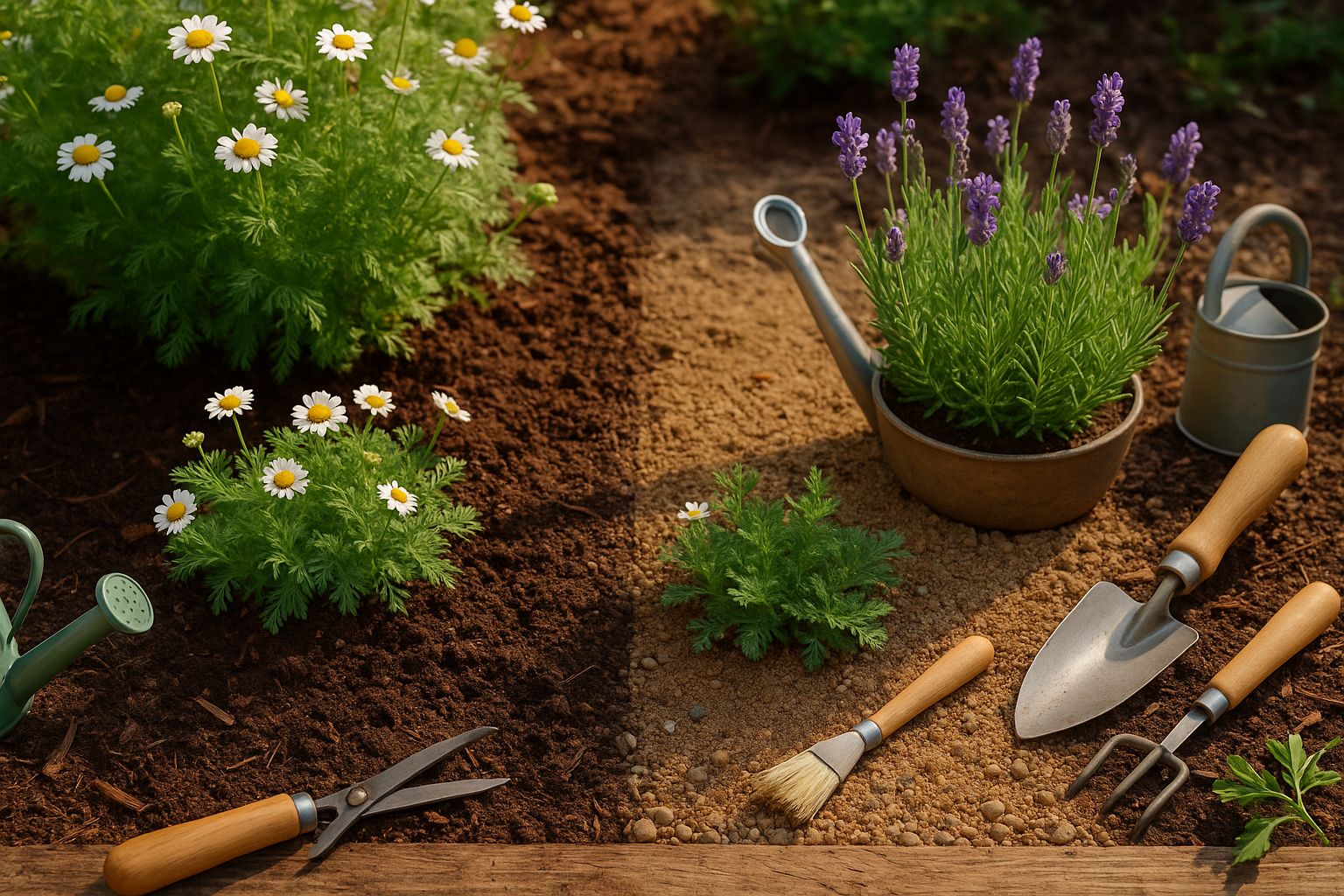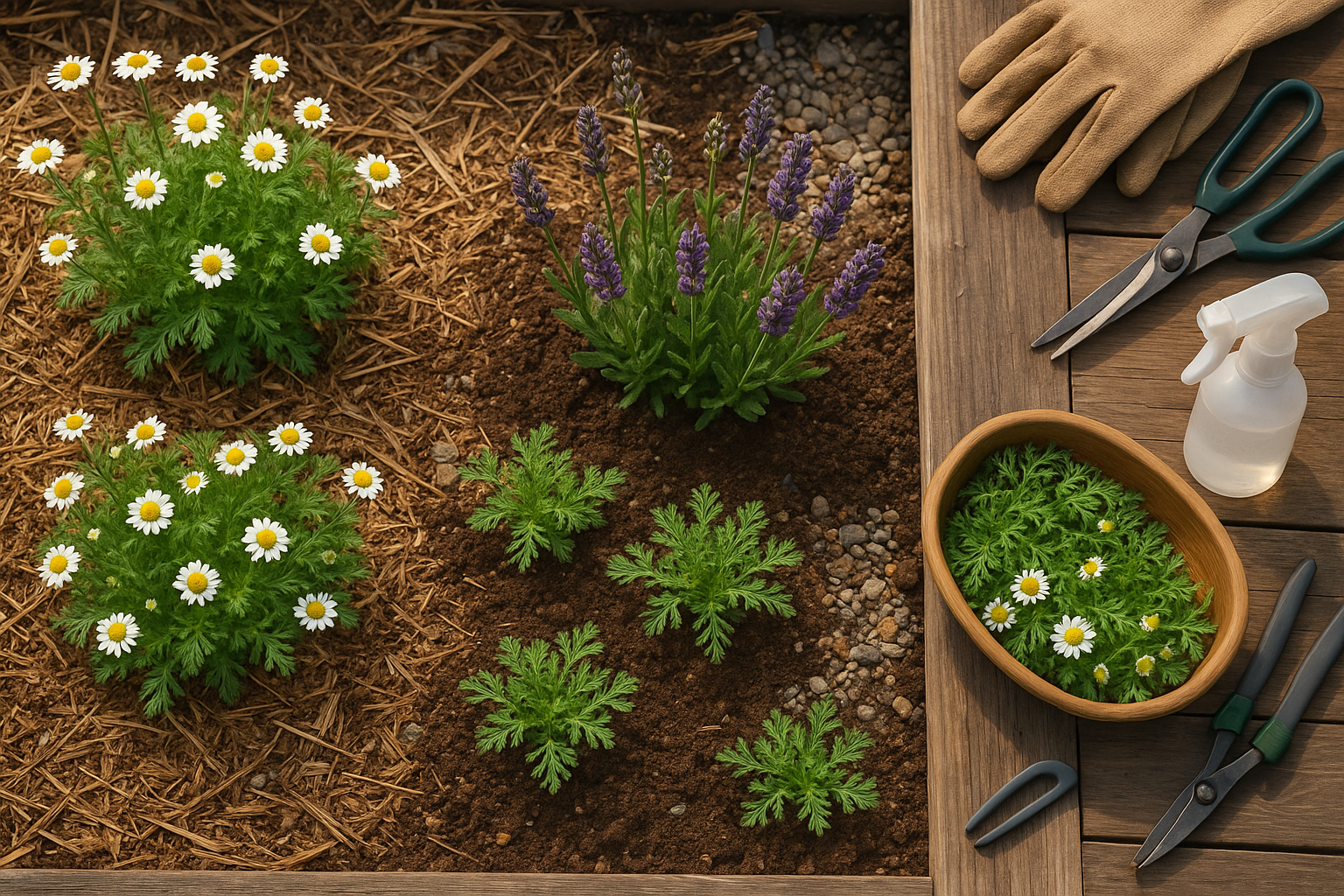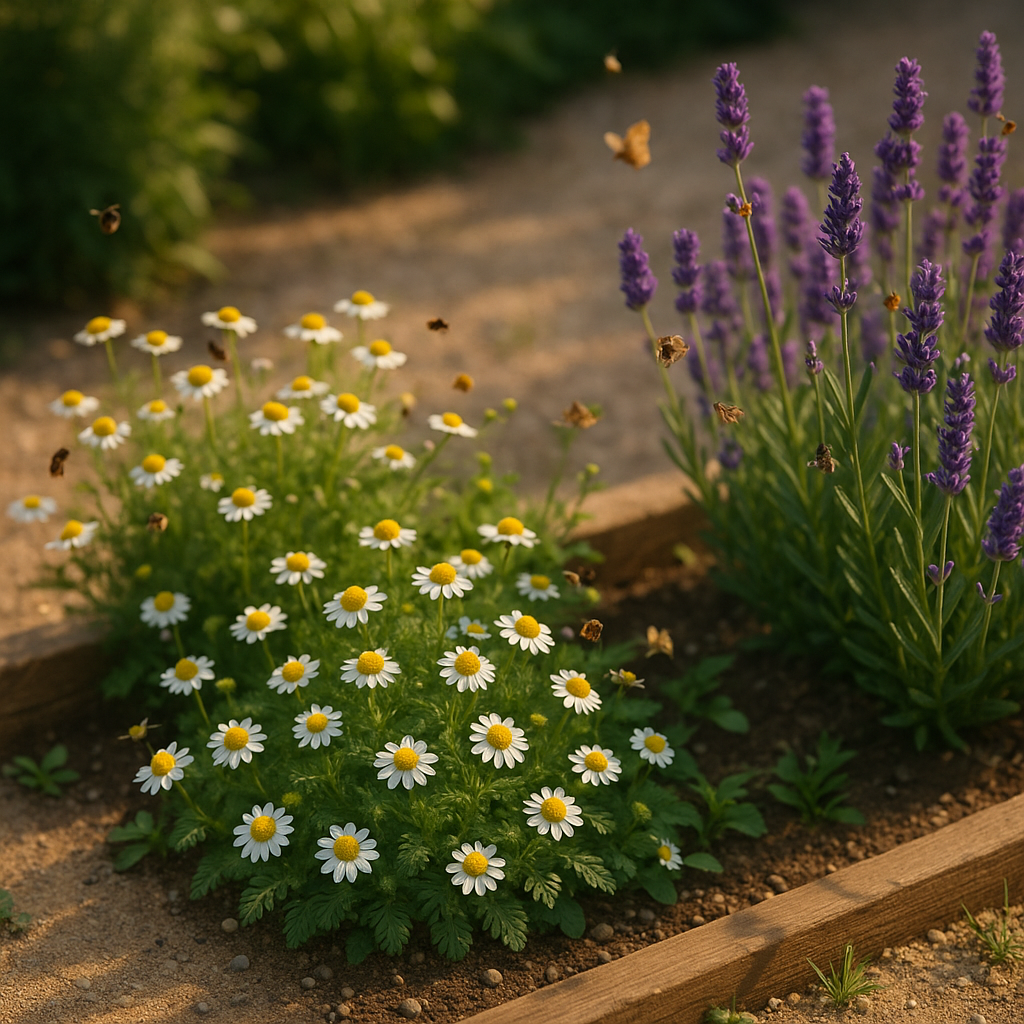Introduction to Chamomile and Lavender
Chamomile and lavender together create more than just a fragrant corner in your garden—they offer a blend of beauty, calm, and tradition that countless gardeners cherish. Both herbs are known for their gentle, soothing properties, making them staples not only in tea blends and home remedies but also as highlights in ornamental beds.
Their sweet scents and delicate blooms transform patios, window boxes, and even kitchen counters into peaceful retreats. Beyond their visual and aromatic charm, growing chamomile and lavender together can be surprisingly practical.
These herbs are renowned for attracting pollinators like bees and butterflies, which helps boost your garden’s overall health. Their natural pest-repelling qualities deter unwanted insects, reducing the need for chemical interventions. Gardeners often find that planting them side by side supports their shared preference for well-drained, sunny spots and can minimize space competition from more aggressive herbs or weeds.
Plus, their combined harvest provides a ready supply of flowers for homemade teas or calming sachets all season long. Whether you’re passionate about natural wellness or simply looking for a low-maintenance way to add color and fragrance to your space, chamomile and lavender together are hard to beat.
Their combined charm extends far beyond the garden, finding a place in everything from soothing baths to sleep-promoting pillows—making them a timeless pair for both novice growers and seasoned herbalists.
Growing Requirements for Chamomile vs. Lavender

Chamomile and lavender are both classic favorites for gardeners, but their growing requirements have some key differences to keep in mind.
Chamomile thrives in well-drained, moderately fertile soil that’s kept consistently moist but never soggy—think of a loamy garden bed that doesn’t bake dry in the hot sun. It enjoys full sun but will tolerate partial shade, making it somewhat adaptable, and prefers regular watering, especially during spells of dry weather.
In contrast, lavender is a true lover of heat and drought. It needs sandy, sharply-drained soil and does best when it’s just a bit on the dry side, so avoid heavy loams or clay that hold onto water. Lavender insists on full sun—at least six hours a day—and too much moisture will lead to root rot, so it’s best to water it sparingly.
When it comes to climate, chamomile is hardy in USDA zones 3-9 and tolerates cooler temperatures, even returning after light frosts in spring. Lavender, depending on the variety, is hardy from zones 5-8 (English lavender is more cold-tolerant than French) and does not perform well in humid or overly wet climates, preferring dry, warm summers.
If you want to grow both plants in the same garden bed, challenges can arise: chamomile likes a bit more moisture and slightly richer soil, while lavender suffers if its roots stay damp or the soil is too rich. To balance both, you might try grouping chamomile together in the slightly moister spots and lavender in raised or border areas with excellent drainage. Alternatively, amend one section of your bed with extra sand or gravel for the lavender and give chamomile the more fertile, moisture-retentive part.
With a bit of careful planning, you can enjoy both of these aromatic classics without compromising on their unique needs.
Companion Planting
Chamomile and lavender can make a lovely pair in the garden, but their compatibility requires a bit of planning. Both are relatively low-maintenance and thrive in similar sunny environments, though their root systems differ. Chamomile has a shallower root system, spreading out close to the surface, while lavender puts down deeper roots that can tolerate drier conditions. This difference can minimize direct competition for water and nutrients if the soil is well-drained and not overly compacted.
In terms of space, chamomile tends to sprawl outward but usually stays low, whereas lavender grows taller and bushier. Leave at least 18 to 24 inches between them to prevent overcrowding and allow good air circulation—crucial for preventing fungal diseases, especially in humid climates.
One advantage of planting these herbs together is their collective impact on pest control: lavender’s fragrant oils repel moths, flies, and mosquitoes, while chamomile attracts beneficial insects like hoverflies and ladybugs that help manage aphid populations.
However, they do have some distinct needs; lavender prefers slightly alkaline, sandy soils and tolerates drought, while chamomile can handle a bit more moisture and richer soil. To give both plants their best shot, amend your soil with sand or gravel for drainage and avoid excessive watering. Mulching lightly with pea gravel can help control weeds without retaining too much moisture.
Monitor for signs of resource competition or stress—such as yellowing leaves or poor blooming—and prune back aggressive chamomile if it threatens to crowd out the lavender. By minding spacing and tailoring your care, chamomile and lavender can coexist beautifully, each supporting a healthy, vibrant garden while delivering their own unique gifts of fragrance, resilience, and natural pest control.
Practical Tips for Successfully Growing Both Herbs Together

Growing chamomile and lavender as companions is a great way to maximize garden space while enjoying their soothing fragrances and benefits. Start by choosing a well-drained garden bed in a sunny spot—both herbs crave at least six hours of sunlight daily.
Prepare the soil by mixing in sand or small gravel to improve drainage, and add compost to enrich nutrients without making it too heavy. Space your lavender and chamomile plants at least 12-18 inches apart; this ensures each herb has enough airflow, minimizing the risk of fungal diseases.
Arrange the taller lavender to the north or west of chamomile if possible, so both get ample sun. Water deeply but infrequently, allowing the soil to dry out between waterings—overwatering is a common issue, especially for lavender, which detests soggy roots.
Apply a light mulch of straw or bark to retain moisture, but keep it an inch away from the stems to deter rot. For pest and disease management, hand-pick pests like aphids or use a gentle spray of soapy water if infestations appear—chamomile often attracts predatory insects that help keep pest populations down naturally.
Removing weeds regularly and cleaning up fallen leaves also helps prevent mildew and other diseases. Rotate your planting areas each year to reduce pest buildup, and avoid chemical treatments that can harm beneficial insects vital to the health of both herbs.
With these steps, you’ll cultivate a thriving, resilient herb duo ready to enrich your cooking and calm your senses.
Uses and Benefits of Chamomile and Lavender
Chamomile and lavender are two powerhouse herbs commonly found in teas, essential oils, skincare, and home remedies. Their calming aromas and flavors make them star ingredients in bedtime teas—when blended, they create a soothing beverage that can help reduce anxiety and promote restful sleep.
In aromatherapy, these herbs are widely used in essential oils: a few drops in a diffuser or diluted in a warm bath can ease stress and lift your mood. They also work well together in massage oils to soothe sore muscles and decrease tension.
Both chamomile and lavender offer remarkable physical health benefits, such as supporting digestion—chamomile soothes stomach cramps while lavender may help relieve nausea. For mental wellness, their gentle sedative properties can reduce mild insomnia symptoms and promote overall relaxation.
Don’t stop at teas and oils—get creative with your harvest!
- Dried chamomile and lavender flowers make fragrant sachets to freshen drawers or keep under pillows for better sleep.
- Culinary lavender pairs beautifully with lemon in cookies or shortbreads, while chamomile can infuse honey or be used in syrups for cocktails.
- Try blending the two into homemade bath salts, adding them to DIY candles, or even mixing petals into oatmeal for a calming breakfast.
By using chamomile and lavender in such a variety of ways, you can enjoy their benefits every day—from relaxation rituals to culinary delights.
Common Questions and Troubleshooting Tips
When planting chamomile and lavender together, spacing is key—give each plant at least 12–18 inches to ensure good airflow and prevent mold or mildew. New gardeners often worry about wilting, which can result from overwatering or poorly draining soil. Both herbs prefer slightly dry conditions, so let the top inch of soil dry out before watering again.
Pests like aphids and spider mites can be a problem, especially for chamomile. Try blasting them off with water or use insecticidal soap as a gentle solution. Lavender and chamomile may also suffer from environmental stress, such as extreme heat or humidity. Make sure they’re planted in a sunny spot with light, well-draining soil. If you live in a humid climate, prune regularly to keep air circulation high.
Harvest chamomile flowers when the petals are flat and vibrant, and pick lavender blooms just as they begin to open for the best fragrance. To keep your herbs healthy, deadhead spent blooms, trim woody growth on lavender in the fall, and remove any yellowing or diseased leaves from both plants. Regular maintenance not only boosts plant health but also ensures a continuous supply of aromatic flowers throughout the growing season.
